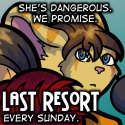"Top 10 Ways to Make your Comic Successful"
... or more importantly, why such things are a crock of [insert favorite word for excrement here].
Yes, I will admit this is self-zinging, because I'm writing a blog on how to make your comic big and yet I'm insulting other people posting about . . . you guessed it, how to make your comic big. It's not that I'm trying to cut down on the competition (though I'd be a fool not to admit I'd like being ahead of the pack).
It's that I'm sick of reading poor excuses for "Do this and suddenly your comic will rock". We all tend to know, instinctively, which ways work and others don't; unless we're incredibly new and naive as to how advertising works, they don't often say anything you don't already know, have tried, and have chiseled at enough to know it's either taking a lot of work a certain way, or like enough to try elsewhere.
Here's a hint: The real tricks that work are the same ones that worked on you when it came to other people's comics.
Your audience, whether you want to admit it or not, is just as smart as (if not smarter than) you, and so anything less is insulting to them. If you notice a certain trick working on you, then you should emulate the same tricks that lured you into reading someone else's comic and adopt them for yourself. Fortunately, this has the advantage of making emulation not just easy, but also proven through your own experience.
The next reason I tend not to like the Laundry Lists of Making Comics Successful is that it assumes all comics are the same sort of material, aimed to the same sort of audience, with the same sort of skew. All other things being equal, it's asinine to think that by doing the exact same thing as everyone else is going to put you AHEAD of everyone else. You're just playing catch-up at this point.
Besides that, if the person giving the advice knew anything of what he was talking about, he wouldn't be telling it to you as a way to get more attention for himself, which (admittedly) most blogs about this sort of niche all have at the heart of things. At least in reading my work, I freely admit I have no clue what's going to make or break me, and by the time I get there, this blog will have already detailed the real tricks involved.
And when I say the 'Real Tricks', I mean I'm not going to tell you to go to site A and register yourself because it worked for me. Here's a quick stab at my own top 10:
- Doing things the way everyone else does them only puts you as far ahead as everyone else.
- There's thousands of webcomics. Make sure yours is different enough to get anywhere.
- Leeching off of other comics' readerships will only get you so far, but at least it's a start.
- Expect to be struggling at it for at least a year. Even on the Internet, cults take time.
- If you can't be regular, neither can your readers.
- Most of the people you're advertising to already read comics. There's far more people in the world who don't. Try advertising to them instead.
- Beware the Family-Friendly label (unless you're really really good at it).
- Your Comic doesn't have a blog. Your Comic IS a blog. Treat it like one.
- Eventually, advertising comics is like advertising anything else.
- You are vying for people's attention spans. Your competition, therefore, is everything else in the world. Start digging the trenches now.
More to the point, once I realize why they're all true, I can stop ranting about everyone else's bad aim.





